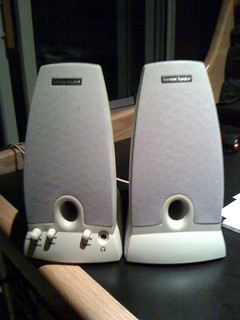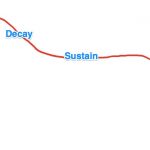Balancing in the Stream
If I was going to describe a lot of my FOH mixes, I would say they have powerful drums and prominent vocals. I’ve noticed a lot of board mixes from others also share this trait to some degree, and I’m starting to notice a lot of streaming mixes sharing the same characteristics.
I think this works fine in a FOH situation, but it doesn’t always translate outside the room so I have a couple of tips for you in getting your streaming balances to work a little better. As with anything, your milage with these may vary.
First tip: Turn Your Monitors Down.
The big, loud drums and way upfront vocals can work at FOH because we usually have a lot of dynamic range available. So even if the instrumentation sits a little low, it’s usually still quite audible and still somewhat connected. In the broadcast environment those same instruments can often feel like they are disconnected and sitting too far back. Vocals in this type of mix also have a tendency to stand on top too much in creating a sort of karaoke feel.
In the early stages of mixing in my studio, it’s not unusual for me to have vocals a little farther forward and instrumentation a bit back from where I ultimately want them. Part of this stems from my years of mixing live sound, but another cause is my monitoring level. I like to start mixes listening at a healthy level some might consider “loud”. I find this works good for getting an initial balance and getting EQ’s working, but once that’s working I do a very simple thing: I turn my monitors down.
At lower listening levels, the difference in the relative balance between things gets a lot more obvious, and I can hear what’s really going on. This is also an important check for me because I don’t know how loud someone is going to listen back to my mix. Some folks might crank it, but others might turn it down. Varying my listening level is a good way to get that balanced.
This is actually a technique I’ve been using for years in the studio. When I mixed North Point Online, I spent a fair amount of time dialing things in on the good monitors, but it wasn’t unusual for me to mix the actual service live on a couple of little speakers I brought to the studio set up on the side playing at a level below conversation level. I still use those speakers today and have a similar setup in my studio. My approach to this is really my adaptation of a technique a lot of A list mix engineers like Chris Lord-Alge and Michael Brauer use where they mix using a boombox.
This leads to my second tip: Listen in Mono.
There are a lot of different opinions on whether or not you should mix in mono or worry about having a mix that works in mono, so here’s my 2 cents on it. Very few people listen in proper stereo. To get proper stereo, you really need to sit between two speakers that are 60 degrees apart. I have that setup in my studio, but most listeners don’t get that at home. Most home listeners using speakers are listening back to something that is somewhere between mono and stereo depending on how close or far away they are from their speakers. Then there’s a whole other thing that happens with people listening through headphones or earbuds that pulls things way outside of stereo, but we can worry about that later.
So take another look at my little speakers in that photo. I keep them off on the side next to each other like that because it simulates mono more along the lines of what happens in a real world listening situation. I have a “mono” button on my monitor controller I use as well for my “good” monitors, but it’s unnecessary for these speakers.
Listening in mono makes center panned stuff jump out more and also mashes stuff together in the frequency spectrum. Monitoring this way helps me get my overall balance a lot tighter, and it also helps me hear where things are masking each other in ways I might not care for.
I don’t exclusively mix in mono, though. I actually spend a fair amount of time listening in stereo because that’s where the fun is. Moving back and forth between the two is also a good way to keep things interesting for me. It also helps by providing a new perspective on the mix as I refine it.
Headphones are a different animal, though, and I don’t worry about them. Headphones tend to make things unnaturally wide, and I figure if I can make stereo and mono work, headphones will more or less work for me as well. Where headphones can get tricky, though, is if it’s all you have to mix with and my guess is in our current COVID-19 season headphones are what a lot of guys are using.
You absolutely can mix through headphones. A plug-in like the Waves Abbey Road Studio 3 can be helpful when mixing with headphones especially if you’re used to working on real speakers, but even that’s not necessary. If you’re using headphones, I think it’s helpful to understand that headphones skew your stereo perspective a bit which, again, is why I think spending time working in mono can be helpful. One of the dangers in using headphones is you might miss an opportunity to get your mix as wide as it should be because it will sound too wide in headphones. Listening in mono on headphones may help you get a more “centered” perspective on what’s happening.
What kinds of things are you struggling with in your streaming mixes? I’d love to hear about your challenges in the comments.


 Next Post
Next Post



Because our mix is coming off a post fade aux from FOH, it took a while to try and get bass, kick sounding good in the mix. Over time I have adjusted the set point for them up a bit from the other instruments in the aux to try and get them to be placed better in the on-line mix. The other thing with this set-up was making sure I wasn’t pulling something down at FOH (because it was naturally loud in the room) like cymbals and snare, and pulling it out of the on-line mix because they don’t get its natural loudness in the room.
I was just mixing an Easter service at home this week and had that same problem with the prominent vocals. Turning it down or listening on another system definitely helps get some perspective!
One big thing I am struggling with is getting that loud rich saturated level to the Broadcast… I’ve been getting a lot of “I had my tv volume at 100 and it was still quiet” even tho the meter on my video switcher shows levels hitting upwards to -3db and RMS around -13. 10db of headroom seems enough in my monitors and still allows for dynamics. when I listen back I have some volume there but the mix sounds very thin, almost Mono… laking that spacial, big stereo spread sound that Im hearing from my monitors and one would expect to hear on the stream… whats going on!?
That is strange. I just looked at some video on your Facebook feed, and the level seems fine and it seems like it’s in stereo. You might need to do a little more digging into some of those comments you’re getting. I wonder if there’s a volume in a streaming player that’s turned down. I wish site’s would remove those because everyone has a volume control on their device.